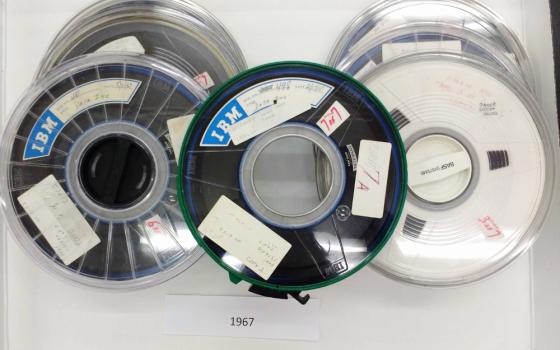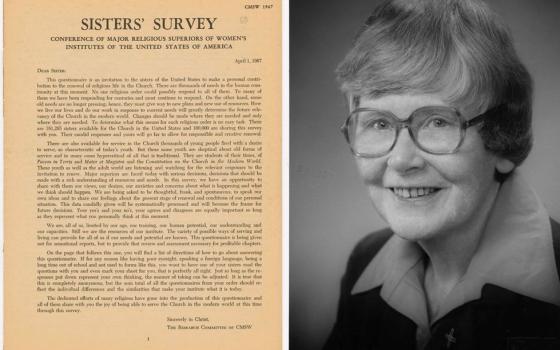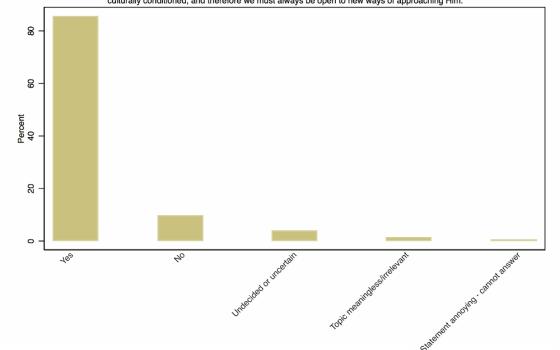In the late 1960s, as the effects of the Second Vatican Council began to reverberate through the Catholic Church, Sr. Marie Augusta Neal of the Sisters of Notre Dame de Namur conducted a survey of American women religious in active ministry.
The survey was mailed to 157,917 sisters in 398 orders, and 89 percent of recipients responded to the questionnaire, which asked the sisters for their individual opinion on topics such as theology, social changes and the Vietnam War and led to detailed analysis of religious life at the time.
Though Neal published her findings from the survey and follow-up work for decades afterward, the data itself — originally encoded on computer punch cards then stored on computer tapes — had been inaccessible to other researchers. But on Oct. 6, the University of Notre Dame announced that Neal's data is now available for researchers around the world to analyze, thanks to a university project.
"It's almost impossible to overstate how significant this dataset is and how having access now will really illuminate not just the history of Catholic sisters, but also a tumultuous time in the United States," said Kathleen Sprows Cummings, director of the University of Notre Dame's Cushwa Center for American Catholicism and associate professor of history and American studies. "I think this is going to be an incredible treasure trove."
"Conference of Major Superiors of Women Sisters' Survey of 1967" was conducted to research the readiness of religious for the renewal and social activism that Vatican II called for, and the questions Neal asked were directed at sisters' willingness to embrace change. The Conference of Major Superiors of Women in 1971 was renamed the Leadership Conference of Women Religious. Neal died in 2004.
Cummings said Neal, who received her doctorate in sociology at Harvard in 1963, was looking for specific things and focused her publications on the data on those same topics.
In 1967, Neal began to present her findings, which showed some sisters were ready for the challenge of renewal but that other sisters were in denial that change was needed. In 1969, she said her data could be used in the self-examination needed for congregations preparing for new chapter decrees and showed links between sisters' attitudes and their choice of missions, with those most ready for change being more willing to adapt radical new directions.
"Before Vatican II, there used to be very simplified categories," Cummings said. "Sisters wore habits, and they were teachers or nurses. Sisters did work that looked like sisters' work. And, for better or worse, people looked at the changes that were happening in very simplistic terms: pre-Vatican II versus post — good or bad."
Having the data accessible will allow a more nuanced look at that period in history, Cummings said.
LCWR's official history says the survey was "designed to provide hard data to individual communities about their members' readiness to adopt Vatican II's mandate for renewal." LCWR officials declined to comment for this story.
Kevin Cawley, curator of manuscripts at the University of Notre Dame Archives, wrote in an email that reforming congregations of sisters was difficult because of the emotions and traditions involved.
"Many found the changes disturbing; many found them exciting," Cawley wrote. "As a sociologist, Sister Marie Augusta Neal hoped to gather data that would allow for scientific analysis, so that in their reforms sisters would not rely only on emotional responses to change, arguments based on anecdotal evidence, or personalities."
Unlocking a digital mystery
In addition to the studies, books and articles Neal wrote, the Notre Dame Archives has a collection of Neal's papers, research notes and other work.
"The data on reels of tape from that early era of computing, transferred to current media by archivists, had until recently been lost to researchers because no key to the information survived," Cawley wrote. "Notre Dame librarians have recovered the key, making the data intelligible again."
The raw data, which LCWR donated to Notre Dame in the 1990s, was just text files filled with a string of more than 90 million numbers.
Notre Dame archivist Charles Lamb worked with Neal to transfer the data from computer tapes to the then-current format of compact discs. He also later oversaw the transfer to a hard drive.
Making the data accessible to others was key, Lamb said.
"We knew it was important not just to look at what she had done," he said. "It's hard for another researcher to come along and just go on someone else's notes, so we knew having the original data accessible was important."
James Ng, a data librarian at Notre Dame, was able to discern the pattern in the lines of numbers of the Neal data, the university said. Once he could see a string of numbers that indicated an individual sister, it became clear the numbers that followed were her responses to each question. That allowed Ng to convert the data into a spreadsheet, and the data that had been locked away for decades became useable and, thanks to the internet, available to researchers.
Before the conversion, researchers would have to travel to Notre Dame, and they could only see the results of Neal's analysis, some of which was on large stacks of green-and-white-striped fan-fold computer paper, Lamb said.
Researchers could see that "she's running these two results against each other, but that may not be the way you want to do it," Lamb said.
Because of restrictions on the gift of the data, the sisters and their answers will remain anonymous, Lamb said: There is no way to tell which congregations the respondents were from, something that was key to Neal's work.
Documenting a time of change
In addition to the timing and the focus of the survey, another remarkable aspect is its scope: Of the 181,285 sisters in the United States in 1967, the survey went to all of the nearly 158,000 in active ministry, and 89 percent of the surveys were returned. A separate survey of contemplative sisters was conducted later.
Carol K. Coburn, a professor of religious studies and women's and gender studies at Avila University, said the response rate also shows the changes that were happening or had not yet taken place: Because the survey was a CMSW project, superiors likely told sisters to complete the surveys, and they did, even though it took hours to answer all 649 questions.
Mary L. Gautier, a senior research associate at the Center for Applied Research in the Apostolate at Georgetown University, called the data "a gold mine" for researchers.
"It was such a huge study. Today you could never get anybody to answer that many questions," Gautier said. "The response rate she got with a survey such as that is just unbelievable."
It was also the first time individual sisters had been asked their personal opinion, said Coburn, who has published and presented extensively on topic of American Catholic sisters.
"I have talked to sisters about this, and they were like, 'Oh, my gosh!' They had never been asked anything. It was a huge, huge shift," she said. "I'm sure it impacted their own sense of identity within their religious orders."
For example, Question 49 asked sisters if they agreed or disagreed with the statement: "I think that sisters who feel called to do so ought to be witnessing to Christ on the picket line and speaking out on controversial issues, as well as performing with professional competence among their lay peers in science labs, at conferences and on the speaker's platform."
Question 81 asked if sisters agreed or disagreed with the statement: "I feel that one of the dangers of the traditional way obedience has been presented in religious communities is that sisters have not been formed to accept personal responsibility for their actions."
The impact of those questions has been debated over the years. According to an article about the conversion project in the Cushwa Center's newsletter, "History of Women Religious," critics say Neal and CMSW used leading questions not to measure sisters' willingness to change, but to promote a particular form of change and to urge discontent with convent life. Others, the article says, have said it was not Neal's or CMSW's intent to change sisters' attitudes, and Neal's methods were the best available at the time.
Providing congregations with this data was vital, Coburn said, because conversations about renewal within sisters' communities were difficult, at best.
"Conversations would go on for hours and hours and hours because it was so emotional," she said. "Once you start getting a group of people to open up and give personal responses and be able to disagree and debate what had not been debatable before that time, that is a scary experience for some people."
The breadth of the study provides a unique look into sisters' lives and attitudes in the late 1960s, Gautier said, which allows for comparisons to modern religious life not available before.
"It gives us a window into how things have changed in the last half-century," Gautier said. "It's kind of like pulling up a time capsule or finding a steamer chest in your attic that your ancestors brought over from the old country."
Gautier said it's too soon to know what analysis will be done on the data, but she expects it to influence research for the next several years.
"We haven't even gotten into it yet — we're still exclaiming over the possibilities," she said. "This is a tremendous gift."
[Dan Stockman is national correspondent for Global Sisters Report. His email address is [email protected]. Follow him on Twitter or on Facebook.]



